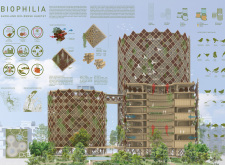5 key facts about this project
The Biophilia project in Auckland, New Zealand, represents a forward-thinking approach to urban architecture that prioritizes ecological integration and community connectivity. This architectural design emphasizes the relationship between humans and nature, creating a habitat that serves multiple functions—residential, commercial, and ecological. The project merges innovative building techniques with a commitment to sustainability, reflecting a growing awareness of the need for greener urban environments.
Design and Structure
Central to the design of the Biophilia project is its double-skin lattice façade, which maximizes natural light while providing essential shading to maintain comfortable internal environments. This outer layer not only serves an aesthetic purpose but also integrates passive cooling strategies, reducing reliance on HVAC systems. The use of cross-laminated timber (CLT) as the primary structural element underscores a commitment to sustainability without sacrificing strength or stability. Additionally, the incorporation of bamboo and recycled materials highlights an environmentally conscious design philosophy.
Unique Features of the Biophilia Project
The project stands out due to its focus on biophilic design principles, which include the incorporation of local flora and fauna into the habitat. By embedding insect and bird houses into the structure, the design actively promotes biodiversity and integrates wildlife into urban living. The multi-tiered layout facilitates diverse functional spaces, including communal gardens and elevated walkways that encourage social interaction among residents. These unique elements position Biophilia as not just a building, but a catalyst for ecological education and community engagement.
Sustainability and Community Engagement
The architectural design addresses critical environmental issues by significantly reducing its ecological footprint. Features such as passive cooling, extensive greenery, and the use of renewable materials contribute to energy efficiency and a reduced environmental impact. The project further emphasizes community by providing public green spaces, reinforcing social connections within the urban fabric. The collaborative layout encourages residents to engage with one another and the environment, demonstrating that sustainable architecture can foster a sense of belonging.
To explore the intricate architectural plans, sections, and designs that further elaborate on the Biophilia project, readers are encouraged to examine the project presentation for a comprehensive understanding of its innovative ideas and implementation.























